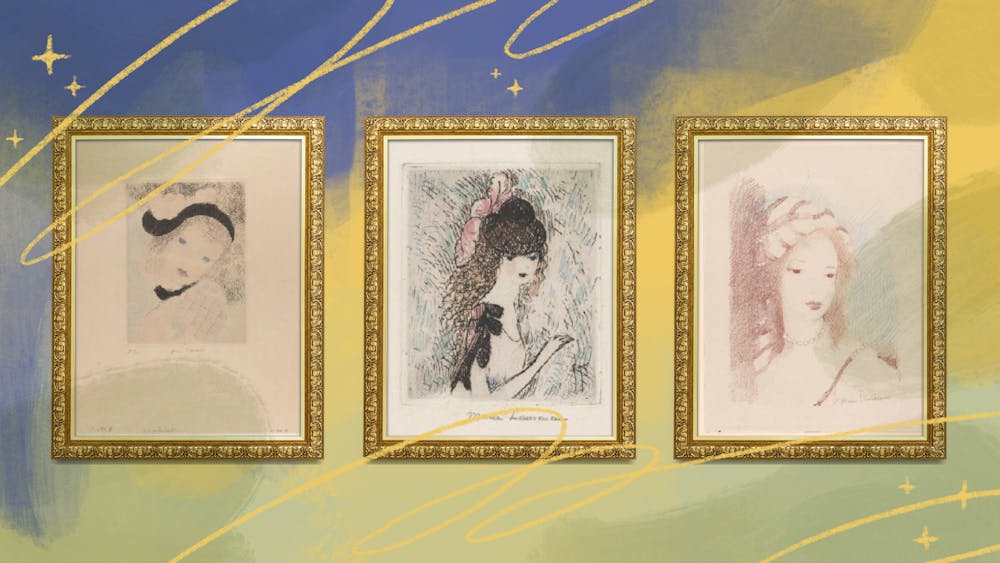“Why should I paint dead fish, onions, and beer glasses? Girls are much prettier,” said Marie Laurencin, the painter who wasn't satisfied by how reality presented itself. Instead, she was mesmerized by dreamlike versions of life. Laurencin, despite creating a unique style of her own, is yet another female artist who’s been left out of the popular canon.
When you think of Cubism, famous artists such as Picasso and Braque come to mind. Contrastly, Laurencin was forgotten by the French art scene and by the movement in which she developed an unprecedented approach. She is often regarded for her romantic involvement with poet Guillaume Apollinaire, following a common fate of many women throughout history: being remembered for a relationship with a man. Apollinaire even nicknamed Laurencin as "Our Lady of Cubism." Despite this, Laurencin is widely seen as a muse as opposed to an artist, who is passively posing the 20th century's most relevant and unique art movements: Fauvism and Cubism.
Laurencin was a 20th–century “It Girl” in many aspects of her life: an uninhibited, unapologetic, and expressive woman who created and shaped artistic trends to her own perspectives. For example, her design for the Ballet Russe Les Biches [The Does], with loose, corset–less dresses, decisively influenced 20th–century women's fashion, something usually attributed to male designers such as Paul Poiret.
In comparison to Picasso, Laurencin’s work contains less harshness and more awe and defiance. At the age of twenty–five, the artist sold a painting to Gertrude Stein (1874–1946), an American collector and modern art enthusiast living in Paris. The painting Group of Artists (1908) depicts people Laurencin was acquainted with: Apollinaire (in the center of the painting); Fernande Olivier and Picasso (represented in the corners). Laurencin's pictorial strategy in this painting is the arranging of her subjects on her canvas in her own space. She relegated Picasso to the lower left corner, contrasting the rigidity of his contours with his profile face. Although Apollinaire is seated center stage, Laurencin reverses the gender convention of the family patriarchal portrait; she reclaims protagonism as the leader of the group. With this painting, Laurencin positioned herself not only in relation to her male colleagues—who evidently had an easier time establishing themselves as artists—but presented a broader political subtext.
At the Philadelphia Museum of Art, visitors can see eight of Laurencin’s works, including two of her most famous paintings: “Nymph and Hind” and “Leda and the Swan.” In her paintings, the viewer enters a Pinterest–like world of young women floating above abstract backgrounds, gray pigeons, and idyllic pastel–green landscapes. She searched for the “pretty” in the world, a pretty that embraced femininity, rather than seeing it as a weakness. Laurencin’s audiences received her sceneries as encouragement and hope for the people facing difficult times and grappling with questions of their own identity. These paintings, markedly feminine and French, helped the country regain a sense of national unity post–World War I.
Laurencin’s personal life was as free as the scenarios in her paintings. She lived the majority of her life with Suzanne Moreau, defying society’s standards by adopting her as her daughter in order for them to share a life together. French law wouldn’t recognize same–sex civil unions until 1999. In fact, Laurencin envisioned a feminine utopia, celebrating women with poetry and prose and creating art that was subtle and subversive at the same time. Her queer modernist identity is visible in all of her art, from Lesbian Friends (1930) to Portrait of Mademoiselle Chanel (1923). She created a language of female creativity and lesbian desire, also leading the epicenter of queer expatriate women in Paris, cultivating friendships with other female lesbian artists, such as writer Natalie Clifford Barney and Gertrude Stein.
By centering all her paintings around female figures, Laurencin explored them in new ways. Approaching sensuality, dedication, mystery, and fantasy, she pursued a tender and serious study of the soul of her models to capture their essence. However, curiously, French fashion designer Coco Chanel sent back her portrait for not recognizing herself in the painting. Marie painted Coco with black eyes, invisible eyebrows, and a hidden forehead.
Like our contemporary “It Girls,” Maurie Laurencin was confident in her artistic endeavors and continued channeling the defiant feminine spirit in her work, not letting male critiques dictate her artistic technique. By the end of her life, Marie Laurencin produced about 2000 paintings, more than 300 prints, book illustrations, scenery, and costumes. In terms of her works, Laurencin is still very modern: her passion for female representation, fashion, and her ability to enter male–dominated spaces are common to many modern women today.

